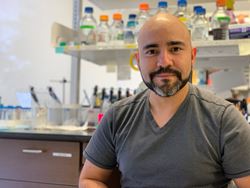We spoke with Juan Codocedo, PhD, Nur Jury-Garfe, PhD and Pablo Martinez, PhD about their backgrounds and pursuit of science.

Juan Codocedo, PhD, assistant research professor of anatomy, cell biology and physiology in the Gary Landreth lab.
What research do you focus on?
My research focuses on the role of metabolism in the activation of brain macrophages, called microglia, during the progression of diseases like Alzheimer’s and traumatic brain injury.
What does it mean to you to be a Latino scientist?
Being a Latino scientist working outside of Latin America means responsibility. I feel that every Latino who gets a position in academia, particularly outside of our frontiers, wants to demonstrate that our training as scientist is equivalent to that of Europe or America. In that sense, I believe that my performance as a scientist is meaningful for my personal development, and it also can open the door for the future generation of scientists from Latin America.
What aspects of your cultural identity make you feel proud?
I come from a country with many natural disasters, so being resilient in the face of adversity—something so valuable when you work in academia—is something that makes me proud. Working in the field of science in Latin America involves less infrastructure and resources, but that also forces us to be creative in the way we need to solve our experiments and hypotheses. Finally, being able to bring diversity to an already culturally rich environment like Stark is something that not only makes me proud but also happy.
 Nur Jury-Garfe, PhD, assistant research professor of anatomy, cell biology and physiology in the Cristian Lasagna-Reeves lab.
Nur Jury-Garfe, PhD, assistant research professor of anatomy, cell biology and physiology in the Cristian Lasagna-Reeves lab.
What research do you focus on?
Past research in the neurodegeneration field has focused on detrimental factors, but it is increasingly recognized that protective mechanisms that could slow down or even prevent the pathology are extremely important to develop preventive medicine. Here is where my research takes place: I’m trying to understand the molecular mechanism which makes certain people live into old age without manifest symptoms of dementia but are later found at autopsy to have brains with high loads of plaques and tau aggregates. Those individuals are known as Alzheimer’s disease resilient and could help to develop alternative therapeutic strategies.
What does it mean to you to be a Latina scientist?
Talk about resilience—being a Latina scientist means creativity and passion. In general, Latino scientists are aware about the deficiencies our land has had for decades in terms of science and technology, but this is what has shaped us to find hundreds of solutions to scientific problems. We want to contribute to the development of medicine in our countries and the main challenges of the 21st century.
What aspects of your cultural identity make you feel proud?
The smile in the face of adversity, the conviviality and the food! Also, I’m very proud of all the woman and girls who are making science in Latin America, despite all the challenges.
 Pablo Martinez, PhD, assistant research professor of anatomy, cell biology and physiology in the Cristian Lasagna-Reeves lab.
Pablo Martinez, PhD, assistant research professor of anatomy, cell biology and physiology in the Cristian Lasagna-Reeves lab.
What research do you focus on?
One of the most important hallmarks of Alzheimer’s disease and other neurodegenerative disorders is the accumulation of pathological tau within the brain. My research focuses on understanding the role of the tau interactors that contribute to tau toxicity and propagation. We hypothesize that the inhibition of these pathological interactions could be a new therapeutic approach for neurodegenerative tauopathies.
What does it mean to you to be a Latino scientist?
It means responsibility. I come from Chile, where science has been a state policy for a very short time; you can see it reflected in its low percentage of GDP for research. Despite this, the scientific quality is very high, which means the responsibility to keep this high level of research outside my country. I always want to do my best on my behalf and on behalf of the community that I represent.
What aspects of your cultural identity make you feel proud?
From a cultural aspect, I think it is the charisma and the closeness with which we connect with other people, whether in our neighborhood, with friends, at church, at work, etc. I can also see that view in the lab since we try to gather around, celebrating the good results/publications or just supporting each other during hard times.
